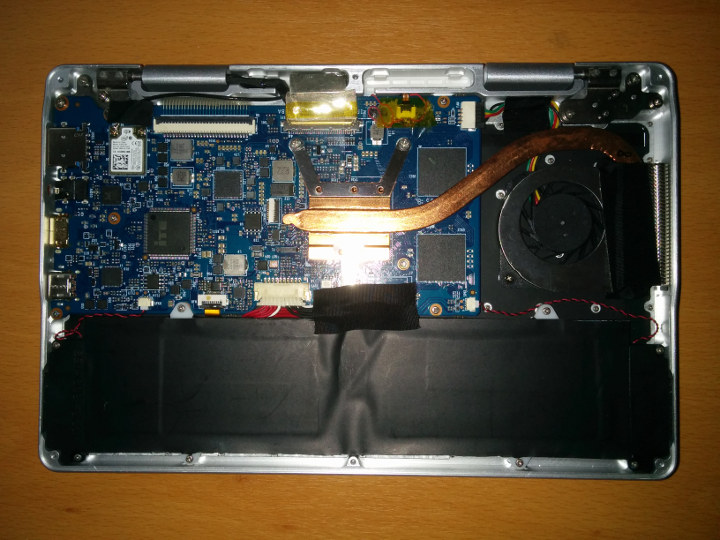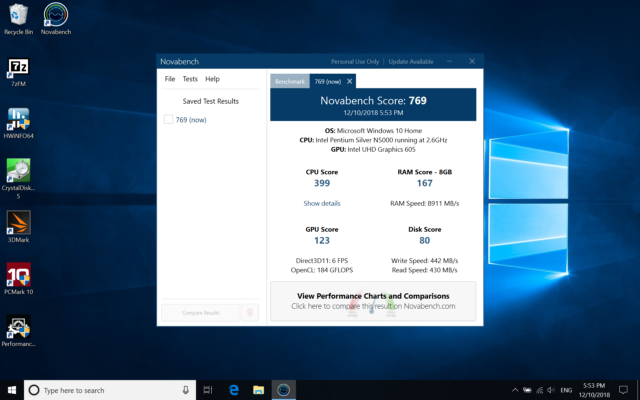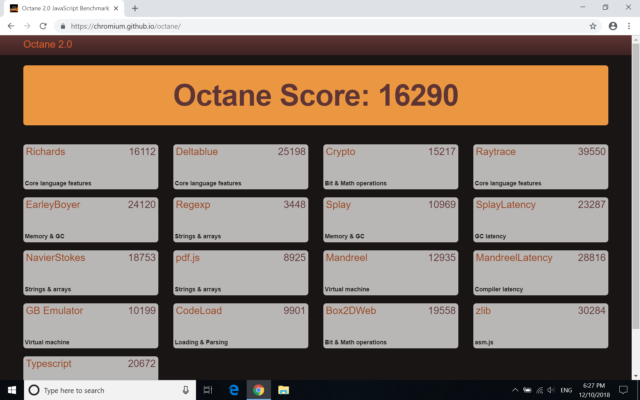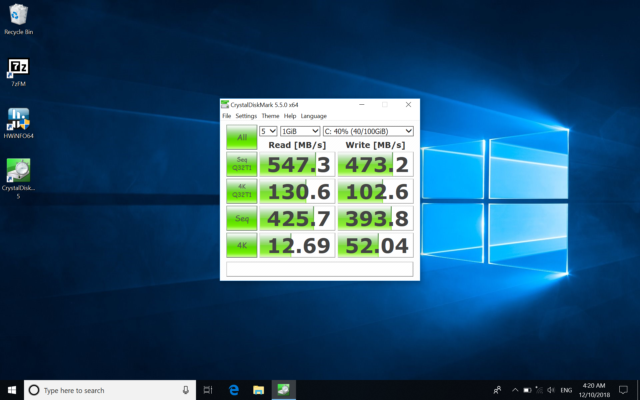The Topjoy Falcon is a mini laptop reminiscent of netbooks and similar to the recent GPD Pocket 2 or One Mix Yoga devices.
Marketed as an 8 inch (203mm) pocket-sized computer with the following specification:
- Intel Pentium SilverN5000CPU
- 8GRAM
- 256GSSDdisk
- 1920*1200FHDIPStouchscreen
- 6000 mAh battery for up to 8 hours working time
- 1 x USB A 3.0, 1 x USB Type-C
- 1 x 3.5mm headphone jack
- 1 x Mini HDMI port
- Activecooling
- 802.11ac WiFi, Bluetooth 4.0
- Backlit keyboard
- Windows 10 Home
- Weight 550g (1lb 3oz)
- Fits easily in your pocket
Although you would need a large pocket as whilst It is physically small consisting of an approximately 8″ by 5.2” and about 0.7” thick (203mm x 132mm x 18mm) when closed it is in reality too big for the average pocket.
It will soon be available on Kickstarter with an early bird price of $399 and an expected retail price of $699.
I’ve received an early prototype which I’ll review below. The first point to note is that being a prototype there are some outstanding issues already identified and will be addressed:
- Type-C port: The prototype’s Type-C port locates a little “deeper” than normal requiring a power adapter with a “longer head”. Other Type-C cables or hubs can’t work on Falcon now. We will fix this.
- G-Sensor doesn’t work well.
- When close the laptop, the screen won’t turn off.
- When use it as a tablet, the keyboard won’t lock.
- The screen is a little bit heavy so that the laptop may fall backward when open. We will adjust the screen weight.
- Mouse right click button doesn’t work.
- A button on the keyboard can turn on/off the cooling fan. It doesn’t work now.
- The battery indicator doesn’t work well.
- The cooling fan of the sample doesn’t work well. This will affect its performance.
The specifications of the prototype differ in that the SSD is only 128GB, it weighs 703g (1lb 9oz) and Windows 10 is not activated otherwise everything else is as stated.
The device came fully installed complete with a random user set up and various movie clips loaded. I mistakenly reset Windows selecting ‘remove everything’ and immediately found that the drivers could not be found to re-enable touch screen or the included touch pen.
Fortunately I had “played’ with the device before resetting it and found the screen was responsive to touch although the calibration was slightly out when using the touch pen.
So now with a clean Windows installation I started with a quick look at the hardware information:



I partitioned the main drive so I could install Ubuntu later:

As usual I ran my standard set of benchmarking tools to look at performance under Windows:
So bearing in mind the cooling fan issue and its impact on performance let’s look at the results compared to other Intel mini PCs:
[capion id="attachment_61034" align="aligncenter" width="720"] Click to Enlarge[/caption]
Click to Enlarge[/caption]
Overall the results are very good with the fan’s impact only being seen on the 2D graphics performance which is lower than expected.
I was also able to run Ubuntu on the device by respining the Ubuntu 18.04.1 LTS ISO and updating with the latest mainline kernel and I installed Ubuntu as dual boot Ubuntu.
Interestingly everything works: WiFi, Bluetooth, audio and touch screen. Initially there is an issue with the screen rotation but this can be fixed by the ‘xrandr’ command.

I first ran some basic commands to look at the hardware in more detail:
|
1 2 3 4 5 6 7 8 9 10 11 12 13 14 15 16 17 18 19 20 21 22 23 24 25 26 27 28 29 30 31 32 33 34 35 36 37 38 39 40 41 42 43 44 45 46 47 48 49 50 51 52 53 54 55 56 57 58 59 60 61 62 63 64 65 66 67 68 69 70 71 72 73 74 75 76 77 78 79 80 81 82 83 84 85 86 87 88 89 90 91 92 93 94 95 96 97 98 99 100 101 102 103 104 105 106 107 108 109 110 111 112 113 114 115 116 117 118 119 120 121 122 123 124 125 126 127 128 129 130 131 132 133 134 135 136 137 138 139 140 141 142 143 144 145 146 147 148 149 150 151 152 153 154 155 156 157 158 159 160 161 162 163 164 165 166 167 168 169 170 171 172 173 174 175 176 177 178 179 180 181 182 183 184 185 186 187 188 189 190 191 192 193 194 195 196 197 198 199 200 201 202 203 204 205 206 207 208 209 210 211 212 213 214 215 216 217 218 219 220 221 222 223 224 225 |
linuxium@falcon:~$ lsb_release -a Distributor ID: Ubuntu Description: Ubuntu 18.04.1 LTS Release: 18.04 Codename: bionic linuxium@falcon:~$ linuxium@falcon:~$ uname -a Linux falcon 4.19.0-041900rc7-generic #201810071631 SMP Sun Oct 7 16:33:10 UTC 2018 x86_64 x86_64 x86_64 GNU/Linux linuxium@falcon:~$ linuxium@falcon:~$ inxi -Fc0 System: Host: falcon Kernel: 4.19.0-041900rc7-generic x86_64 bits: 64 Console: tty 1 Distro: Ubuntu 18.04.1 LTS Machine: Device: desktop Mobo: N/A model: N/A serial: N/A UEFI: American Megatrends v: GN8V001 date: 09/28/2018 Battery BAT0: charge: 20.5 Wh 54.0% condition: 38.0/38.0 Wh (100%) hidpp__0: charge: N/A condition: NA/NA Wh CPU: Quad core Intel Pentium Silver N5000 (-MCP-) cache: 4096 KB clock speeds: max: 2700 MHz 1: 2432 MHz 2: 534 MHz 3: 531 MHz 4: 573 MHz Graphics: Card: Intel Device 3184 Display Server: X.Org 1.19.6 driver: i915 Resolution: 1200x1920@60.00hz OpenGL: renderer: Mesa DRI Intel UHD Graphics 605 (Geminilake) version: 4.5 Mesa 18.0.5 Audio: Card Intel Device 3198 driver: snd_hda_intel Sound: ALSA v: k4.19.0-041900rc7-generic Network: Card: Intel Wireless 3165 driver: iwlwifi IF: wlp1s0 state: up mac: 5c:5f:67:17:35:e0 Drives: HDD Total Size: 128.0GB (6.6% used) ID-1: /dev/sda model: FORESEE_128GB_SS size: 128.0GB Partition: ID-1: / size: 19G used: 7.8G (46%) fs: ext4 dev: /dev/sda5 RAID: No RAID devices: /proc/mdstat, md_mod kernel module present Sensors: System Temperatures: cpu: 53.0C mobo: N/A Fan Speeds (in rpm): cpu: N/A Info: Processes: 260 Uptime: 1:05 Memory: 1292.3/7795.6MB Client: Shell (review-tests.sh) inxi: 2.3.56 linuxium@falcon:~$ linuxium@falcon:~$ df -h Filesystem Size Used Avail Use% Mounted on udev 3.8G 0 3.8G 0% /dev tmpfs 780M 2.1M 778M 1% /run /dev/sda5 19G 7.8G 9.5G 46% / tmpfs 3.9G 0 3.9G 0% /dev/shm tmpfs 5.0M 4.0K 5.0M 1% /run/lock tmpfs 3.9G 0 3.9G 0% /sys/fs/cgroup /dev/loop0 13M 13M 0 100% /snap/gnome-characters/103 /dev/loop1 35M 35M 0 100% /snap/gtk-common-themes/319 /dev/loop2 3.8M 3.8M 0 100% /snap/gnome-system-monitor/51 /dev/loop3 15M 15M 0 100% /snap/gnome-logs/37 /dev/loop4 87M 87M 0 100% /snap/core/4917 /dev/loop5 2.4M 2.4M 0 100% /snap/gnome-calculator/180 /dev/loop6 141M 141M 0 100% /snap/gnome-3-26-1604/70 /dev/sda1 96M 49M 48M 51% /boot/efi tmpfs 780M 16K 780M 1% /run/user/121 tmpfs 780M 32K 780M 1% /run/user/1000 tmpfs 780M 4.0K 780M 1% /run/user/0 /dev/loop7 88M 88M 0 100% /snap/core/5548 /dev/loop8 3.8M 3.8M 0 100% /snap/gnome-system-monitor/57 /dev/loop9 13M 13M 0 100% /snap/gnome-characters/124 /dev/loop10 2.3M 2.3M 0 100% /snap/gnome-calculator/238 /dev/loop11 15M 15M 0 100% /snap/gnome-logs/45 /dev/loop12 43M 43M 0 100% /snap/gtk-common-themes/701 linuxium@falcon:~$ linuxium@falcon:~$ lsblk -a NAME MAJ:MIN RM SIZE RO TYPE MOUNTPOINT loop0 7:0 0 13M 1 loop /snap/gnome-characters/103 loop1 7:1 0 34.7M 1 loop /snap/gtk-common-themes/319 loop2 7:2 0 3.7M 1 loop /snap/gnome-system-monitor/51 loop3 7:3 0 14.5M 1 loop /snap/gnome-logs/37 loop4 7:4 0 86.9M 1 loop /snap/core/4917 loop5 7:5 0 2.3M 1 loop /snap/gnome-calculator/180 loop6 7:6 0 140.9M 1 loop /snap/gnome-3-26-1604/70 loop7 7:7 0 87.9M 1 loop /snap/core/5548 loop8 7:8 0 3.7M 1 loop /snap/gnome-system-monitor/57 loop9 7:9 0 13M 1 loop /snap/gnome-characters/124 loop10 7:10 0 2.3M 1 loop /snap/gnome-calculator/238 loop11 7:11 0 14.5M 1 loop /snap/gnome-logs/45 loop12 7:12 0 42.1M 1 loop /snap/gtk-common-themes/701 sda 8:0 0 119.2G 0 disk ├─sda1 8:1 0 100M 0 part /boot/efi ├─sda2 8:2 0 128M 0 part ├─sda3 8:3 0 100G 0 part ├─sda4 8:4 0 480M 0 part └─sda5 8:5 0 18.6G 0 part / linuxium@falcon:~$ linuxium@falcon:~$ sudo lshw -C cpu *-cpu description: CPU product: Intel(R) Pentium(R) Silver N5000 CPU @ 1.10GHz vendor: Intel Corp. physical id: 1e bus info: cpu@0 version: Intel(R) Pentium(R) Silver N5000 CPU @ 1.10GHz slot: SOCKET 0 size: 2621MHz capacity: 2700MHz width: 64 bits clock: 100MHz capabilities: x86-64 fpu fpu_exception wp vme de pse tsc msr pae mce cx8 apic sep mtrr pge mca cmov pat pse36 clflush dts acpi mmx fxsr sse sse2 ss ht tm pbe syscall nx pdpe1gb rdtscp constant_tsc art arch_perfmon pebs bts rep_good nopl xtopology nonstop_tsc cpuid aperfmperf tsc_known_freq pni pclmulqdq dtes64 monitor ds_cpl vmx est tm2 ssse3 sdbg cx16 xtpr pdcm sse4_1 sse4_2 x2apic movbe popcnt tsc_deadline_timer aes xsave rdrand lahf_lm 3dnowprefetch cpuid_fault cat_l2 pti cdp_l2 ssbd ibrs ibpb stibp ibrs_enhanced tpr_shadow vnmi flexpriority ept vpid ept_ad fsgsbase tsc_adjust smep erms mpx rdt_a rdseed smap clflushopt intel_pt sha_ni xsaveopt xsavec xgetbv1 xsaves dtherm ida arat pln pts umip rdpid arch_capabilities cpufreq configuration: cores=4 enabledcores=4 threads=4 linuxium@falcon:~$ linuxium@falcon:~$ sudo lshw -C memory *-firmware description: BIOS vendor: American Megatrends Inc. physical id: 0 version: GN8V001 date: 09/28/2018 size: 64KiB capacity: 4352KiB capabilities: pci upgrade shadowing cdboot bootselect socketedrom edd int13floppy1200 int13floppy720 int13floppy2880 int5printscreen int14serial int17printer acpi usb biosbootspecification uefi *-memory description: System Memory physical id: b slot: System board or motherboard size: 8GiB *-bank:0 description: DIMM LPDDR4 Synchronous 2400 MHz (0.4 ns) product: 123456789012345678 vendor: ABCD physical id: 0 serial: 1234 slot: A1_DIMM0 size: 2GiB width: 16 bits clock: 2400MHz (0.4ns) *-bank:1 description: DIMM LPDDR4 Synchronous 2400 MHz (0.4 ns) product: 123456789012345678 vendor: ABCD physical id: 1 serial: 1234 slot: A1_DIMM1 size: 2GiB width: 16 bits clock: 2400MHz (0.4ns) *-bank:2 description: DIMM LPDDR4 Synchronous 2400 MHz (0.4 ns) product: 123456789012345678 vendor: ABCD physical id: 2 serial: 1234 slot: A1_DIMM2 size: 2GiB width: 16 bits clock: 2400MHz (0.4ns) *-bank:3 description: DIMM LPDDR4 Synchronous 2400 MHz (0.4 ns) product: 123456789012345678 vendor: ABCD physical id: 3 serial: 1234 slot: A1_DIMM3 size: 2GiB width: 16 bits clock: 2400MHz (0.4ns) *-cache:0 description: L1 cache physical id: 1c size: 224KiB capacity: 224KiB capabilities: synchronous internal write-back configuration: level=1 *-cache:1 description: L2 cache physical id: 1d slot: u size: 4MiB capacity: 4MiB capabilities: synchronous internal write-back unified configuration: level=2 linuxium@falcon:~$ linuxium@falcon:~$ free -mh total used free shared buff/cache available Mem: 7.6G 1.0G 2.1G 342M 4.5G 6.0G Swap: 880M 0B 880M linuxium@falcon:~$ linuxium@falcon:~$ sudo lshw -C network *-network description: Wireless interface product: Wireless 3165 vendor: Intel Corporation physical id: 0 bus info: pci@0000:01:00.0 logical name: wlp1s0 version: 91 serial: 5c:5f:67:17:35:e0 width: 64 bits clock: 33MHz capabilities: pm msi pciexpress bus_master cap_list ethernet physical wireless configuration: broadcast=yes driver=iwlwifi driverversion=4.19.0-041900rc7-generic firmware=29.1044073957.0 ip=xxx.xxx.xxx.xxx latency=0 link=yes multicast=yes wireless=IEEE 802.11 resources: irq:127 memory:a1100000-a1101fff linuxium@falcon:~$ linuxium@falcon:~$ lsusb Bus 002 Device 001: ID 1d6b:0003 Linux Foundation 3.0 root hub Bus 001 Device 004: ID 258a:0021 Bus 001 Device 003: ID 046d:c52b Logitech, Inc. Unifying Receiver Bus 001 Device 002: ID 8087:0a2a Intel Corp. Bus 001 Device 001: ID 1d6b:0002 Linux Foundation 2.0 root hub linuxium@falcon:~$ linuxium@falcon:~$ lspci 00:00.0 Host bridge: Intel Corporation Device 31f0 (rev 03) 00:00.1 Signal processing controller: Intel Corporation Device 318c (rev 03) 00:02.0 VGA compatible controller: Intel Corporation Device 3184 (rev 03) 00:0e.0 Audio device: Intel Corporation Device 3198 (rev 03) 00:0f.0 Communication controller: Intel Corporation Device 319a (rev 03) 00:12.0 SATA controller: Intel Corporation Device 31e3 (rev 03) 00:13.0 PCI bridge: Intel Corporation Device 31d8 (rev f3) 00:15.0 USB controller: Intel Corporation Device 31a8 (rev 03) 00:16.0 Signal processing controller: Intel Corporation Device 31ac (rev 03) 00:16.1 Signal processing controller: Intel Corporation Device 31ae (rev 03) 00:16.2 Signal processing controller: Intel Corporation Device 31b0 (rev 03) 00:16.3 Signal processing controller: Intel Corporation Device 31b2 (rev 03) 00:17.0 Signal processing controller: Intel Corporation Device 31b4 (rev 03) 00:17.1 Signal processing controller: Intel Corporation Device 31b6 (rev 03) 00:17.2 Signal processing controller: Intel Corporation Device 31b8 (rev 03) 00:17.3 Signal processing controller: Intel Corporation Device 31ba (rev 03) 00:18.0 Signal processing controller: Intel Corporation Device 31bc (rev 03) 00:18.1 Signal processing controller: Intel Corporation Device 31be (rev 03) 00:18.2 Signal processing controller: Intel Corporation Device 31c0 (rev 03) 00:18.3 Signal processing controller: Intel Corporation Device 31ee (rev 03) 00:19.0 Signal processing controller: Intel Corporation Device 31c2 (rev 03) 00:19.1 Signal processing controller: Intel Corporation Device 31c4 (rev 03) 00:19.2 Signal processing controller: Intel Corporation Device 31c6 (rev 03) 00:1c.0 SD Host controller: Intel Corporation Device 31cc (rev 03) 00:1e.0 SD Host controller: Intel Corporation Device 31d0 (rev 03) 00:1f.0 ISA bridge: Intel Corporation Device 31e8 (rev 03) 00:1f.1 SMBus: Intel Corporation Device 31d4 (rev 03) 01:00.0 Network controller: Intel Corporation Wireless 3165 (rev 91) linuxium@falcon:~$ |
I then ran my usual suite of Phoronix tests to look at performance in Ubuntu:



The results show as expected performance with the N5000 CPU performing between the J4005 and J5005 processors.
Ubuntu’s Octane result was also tested and it was marginally better than in Windows:

I also looked at real-world usage by playing videos under Windows using both Edge and Chrome browsers. Under both browsers 4K@30fps and 4K@60fps videos played fine:




Although on Chrome the 4K@60fps video had some occasional dropped frames but were unnoticeable while watching.
In contrast playing videos in Chrome on Ubuntu was a similar story to on other Intel processor-based mini PCs with 4K@30fps dropping too many frames and pausing making it really not watchable:

but fine when played at 1440p:

The 4K@60fps video resulted in the frames being dropped and was unwatchable:

However 1080p@60fps was fine with only the occasional unnoticeable dropped frame:

Finally I tried playing some games. First I installed Minecraft and performance was reasonable but loading was slow:
Next I tried streaming a game on Steam which worked fine:
And then to finish I installed a game on Steam playing it locally:
The gaming experience was reasonable and played as expected for this CPU/GPU combo.
Cooling is impacted by the known issue with the fan so I didn’t perform any specific cooling tests. However the body of the device whilst made from aluminum was only slightly warm to touch when the processor was put under load.
As mentioned audio works on Windows and and also on Ubuntu without issues. Network connectivity throughput was measured using ‘iperf’ on Ubuntu:
The network results were comparable with other Intel devices tested.
Finally I measured the battery capacity by fully charging the device and then left it playing and repeating a two hour music video. The battery lasted for 4 hours 50 minutes which is much less than the slated eight hours.
The BIOS appears to be fully locked at this stage:

Overall despite the known limitations being a prototype the device performed well. It is an intriguing little device with ‘little’ being the operative word. I often found myself squinting at the screen to make out text and resorting to one finger typing in order to type more accurately. One major improvement would be the inclusion of a full-sized HDMI port rather than the current mini-HDMI. That would allow easier ‘docking’ to use a monitor and keyboard when needed.
I’d like to thank Topjoy for providing the unit for review and keep an eye on their Facebook page for when it will be available on Kickstarter with an early bird price of $399 and an expected retail price of $699. [Update October 24, 2018: The kickstarter campaign is now live]

Ian is interested in mini PCs and helps with reviews of mini PCs running Windows, Ubuntu and other Linux operating systems. You can follow him on Facebook or Twitter.
Support CNX Software! Donate via cryptocurrencies, become a Patron on Patreon, or purchase goods on Amazon or Aliexpress. We also use affiliate links in articles to earn commissions if you make a purchase after clicking on those links.

























The keyboad is so ugly….
“Fits easily in your pocket”
LOL
retail price of $699 … non sense.
That PC is DOA. I can’t see anyone in their right mind investing in this. I mean the device is ugly and it is way too expensive. I don’t think I could even start to install Linux.
I actually think the small form factor is quite appealing. Nothing special design-wise, but also not particularly ugly, so I really don’t mind. The planned retail price of 699$ seems too high though, I agree. Also not sure if the two-part space bar makes much sense and I’d have much preferred a real Trackpoint, Thinkpad-style – I guess there’s not enough space for that.
Wonder if the pen is any good on this one here? They didn’t actually market the stylus at all so far, doesn’t even show up on the website, which worries me a bit. But if it’s working at least half-decently, for me it’s a worthy contender with the One Mix 2 Yoga.
I haven’t been able to get a clear idea of how big the difference is in performance between the N5000 used in the Falcon vs. the Core-M they are going to use in the One Mix 2, though. For me it mostly comes down to whether the larger screen and keyboard “outweigh” the presumably better performance and lower weight/smaller footprint of the One Mix 2.
Unfortunately, there’s no really interesting, modern 10″ device available that I know of – the Teclast F5 maybe, but the CPU is definitely weaker there. The Lenovo Yoga Book C930 is kind of cool, but I’m not convinced I’d be able to deal with the e-Ink keyboard in the long run (I might rethink if I were sure that I’d be able to use it on Linux and if they’d allow a freer/more flexible use of the e-Ink part as second screen, so that I might use a bluetooth keyboard most of the time). If only Lenovo decided to make a good 10 inch Thinkpad…!